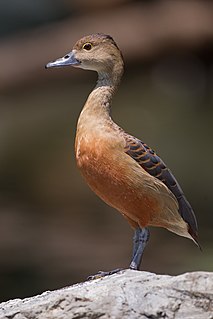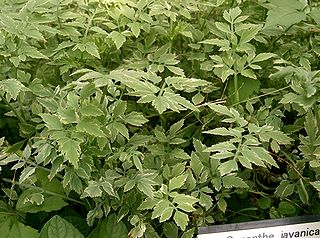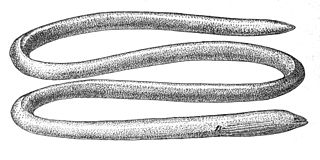
The lesser whistling duck, also known as Indian whistling duck or lesser whistling teal, is a species of whistling duck that breeds in the Indian subcontinent and Southeast Asia. They are nocturnal feeders that during the day may be found in flocks around lakes and wet paddy fields. They can perch on trees and sometimes build their nest in the hollow of a tree. This brown and long-necked duck has broad wings that are visible in flight and produces a loud two-note wheezy call. It has a chestnut rump, differentiating it from its larger relative, the fulvous whistling duck, which has a creamy white rump.

Root-knot nematodes are plant-parasitic nematodes from the genus Meloidogyne. They exist in soil in areas with hot climates or short winters. About 2000 plants worldwide are susceptible to infection by root-knot nematodes and they cause approximately 5% of global crop loss. Root-knot nematode larvae infect plant roots, causing the development of root-knot galls that drain the plant's photosynthate and nutrients. Infection of young plants may be lethal, while infection of mature plants causes decreased yield.
Podadenia is a genus of plant of the family Euphorbiaceae first described as a genus in 1821. At present, only species is recognized in the genus, Podadenia sapida, endemic to Sri Lanka.
Meloidogyne javanica is a species of plant-pathogenic nematodes. It is one of the tropical root-knot nematodes and a major agricultural pest in many countries. It has many hosts. Meloidogyne javanica reproduces by obligatory mitotic parthenogenesis (apomixis).

Brucea is a genus of plant in the family Simaroubaceae. It is named for the Scottish scholar and explorer James Bruce.

The Thyatirinae are a subfamily of the moth family Drepanidae with about 200 species described. Until recently, most classifications treated this group as a separate family called Thyatiridae.

Oenanthe javanica, commonly Java waterdropwort, Chinese celery, Indian pennywort, Japanese parsley, water celery and water dropwort, is a plant of the water dropwort genus originating from East Asia.. It has a widespread native distribution in temperate Asia and tropical Asia, and is also native to Queensland, Australia.
Horithyatira is a genus of moth belonging to the subfamily Thyatirinae.

Horithyatira decorata is a moth in the family Drepanidae. It is found from the north-eastern Himalaya and Nepal to southern China and Taiwan.

Cassia javanica, also known as Java cassia, pink shower, apple blossom tree and rainbow shower tree, is a species of tree in the Fabaceae family. Its origin is in Southeast Asia, but it has been extensively grown in tropical areas worldwide as a garden tree owing to its beautiful crimson and pink flower bunches.

The Java spaghetti eel, also known as the Java thrush-eel, Java worm eel, and the black-tailed thrush eel is an eel in the family Moringuidae. It was described by Johann Jakob Kaup in 1856, originally under the genus Aphthalmichthys. It is a tropical, marine eel which is known from the Indo-Pacific, including East Africa, the Tuamoto Islands, the Ryukyu Islands, and Micronesia. It is a burrowing species which inhabits reefs at a depth range of 2–15 m. Males can reach a maximum total length of 120 cm.
Ceryx javanica is a moth of the subfamily Arctiinae. It was described by Obraztsov in 1949. It is found on Java.
Ratarda javanica is a moth in the family Cossidae. It is found on Java.
Filopaludina javanica or Idiopoma javanica is a species of large freshwater snail with a gill and an operculum, an aquatic gastropod mollusk in the family Viviparidae.

Brucea javanica is a shrub in the family Simaroubaceae. The specific epithet javanica is from the Latin, meaning "of Java". Other common names in English include Java brucea and kosam.
Horithyatira diehli is a moth in the family Drepanidae. It is found in Indonesia (Sumatra) and India (Assam).
Horithyatira ornata is a moth in the family Drepanidae. It is found in Indonesia (Java).
Thyatira delattini is a moth in the family Drepanidae. It was described by Werny in 1966. It is found in New Guinea.
Castanopsis javanica, the Javan chestnut-oak, is a tree in the beech family Fagaceae. The specific epithet javanica is from the Latin, meaning "of Java".










